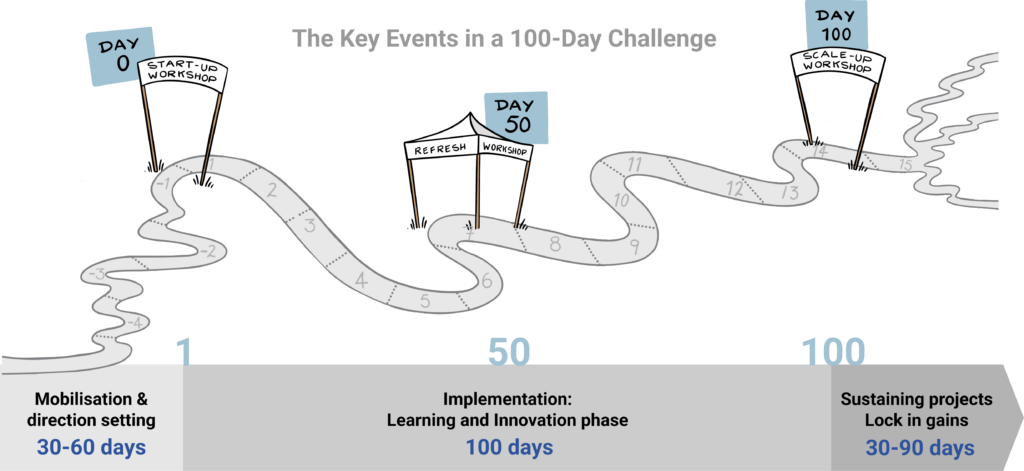Frequently Asked Questions (& Answers)
100-Day Challenges at a Glance
Question:
What is a 100-Day Challenge?
<div style=”padding:56.25% 0 0 0;position:relative;”><iframe src=”https://player.vimeo.com/video/1056474522?badge=0&autopause=0&player_id=0&app_id=58479″ frameborder=”0″ allow=”autoplay; fullscreen; picture-in-picture; clipboard-write; encrypted-media” style=”position:absolute;top:0;left:0;width:100%;height:100%;” title=”100DC intro Part 2″></iframe></div><script src=”https://player.vimeo.com/api/player.js”></script>
A 100-Day Challenge is a rapid (100-day) project that makes significant progress on a strategically important issue – one that typically requires fresh thinking and collaboration across departments and/or organisations.
The project is done as a structured journey for frontline teams and leaders, and it is designed to inspire and enable intense collaboration, continuous innovation, and fast and disciplined implementation. Teams start this journey by setting unreasonable 100-Day Goals and developing innovative plans to achieve these. To set the stage for the journey, leaders shape and present a challenge to the team and create a “safe space” for the team to experiment and learn. A Sustaining Phase (beyond the 100 days), involving Leadership Stakeholders and 100-Day Team members, ensures that the gains are sustained after the 100-Days.
The 100-Day Challenge project involves 3 interconnected events (workshops), each building on the other. The graphic below shows these three workshops (Start-Up; Refresh, and Scale-Up) as part of a relay race.

Three Types of Impact in Every 100-Day Challenge
Performance Increases
Insight about System Patterns
Transformative Experience
Question:
What is the Rhythm of a 100-Day Challenge?
A full cycle of the 100-Day Challenge, including the pre- and post-100-day work, lasts several months. The graphic shows a race track, with a stretch of terrain before the Starting Gate, and a stretch beyond the Finish Line.
The 100-Day Challenge can be viewed as a relay race, with the baton being passed between the different athletes. Unlike real relay races, when athletes pass on the baton they do not get out of the race. They continue running alongside the athlete with the baton, supporting and cheering them along.

Click on the black boxes below to see more detail about each stage of the Relay Race.
Santa: could we make the title boxes more like sqaures that accommodate two lines of text (move Workshop to second line), so they fit alongside each other rather than having the the last one hang on the lower line?

Pre Start-Up Workshop
Focus: Challenge Strategist consults with leadership stakeholders to decide on the focus of the Challenge
Team: Challenge Strategist consults with leadership stakeholders to select and recruit 100-Day Team members.
Coach: Challenge Strategist recruits Team Coach to support her and to guide the 100-Day Team

Start-Up Workshop
Goal: The Team sets its 100-Day Goal
Plan: The Team develops its initial 100-Day Plan
Process: The Team elects a Team Leader, and it develops a Team Operating Agreement.

Refresh Workshop
Goal Revisited: The Team assesses progress, and it confirms or adjusts the 100-Day Goal as needed.
Plan Adjusted: The Team adjusts its 100-Day Plan for the remainder of the race.
Team Dynamics: The Team assesses its own dynamics, and it adjusts the Team Operating Agreement as needed.

Scale-up Workshop
Celebrate: The Team celebrates achievements and shares lessons learned
Sustain: The Team recommends ways to sustain the impact
Amplify: The Team and leaders map out options to build on the 100-Day Challenge

Post Scale-Up
Path Forward: Challenge Strategist & Team Coach help leadership stakeholders decide on the path forward
Governance: Leadership stakeholders, guided by the Challenge Strategist, recruit Challenge Strategists and Team Coaches to guide and support future 100-Day Challenges and other related projects.
Question:
What are the Roles involved in this Work?

Leadership Stakeholders
Leadership Stakeholders are senior representatives in the organisation or systems engaged in the issue at hand. They decide on a focus area for the 100-Day Challenge and propose members for the 100-Day Team.
Leadership Stakeholders play an active role during the Challenge. They ensure that Team members have the time and space to participate in the Challenge, and they bust down barriers the team may encounter as they engage in experiments to improve the system.
Leadership Stakeholders will also ensure the sustainability of the Challenge’s efforts through the sustaining phase, which comes after the completion of the 100 days.
Challenge Strategist
A Challenge Strategist provides the inspiration and energy to bring 100-Day Challenges into existence and put the 100-Day teams on the proper track to run their race. The Challenge Strategist cheers Team members along during their 100-day race. This is a very critical role.
There is an accountability relationship between the 100-Day Challenge Team and Challenge Strategist. The team, or the Team Leader, “reports” to the Challenge Strategist as the representative of the Leadership Stakeholders. However, it is important to note that one of the reasons that 100-Day Challenges are so impactful is that they involve a unique way to handle power within and between organisations. So even though Challenge Strategists are in a position of power vis-a-vis the team, 100-Day Challenges are an opportunity for the Challenge Strategist to practise “power with” and “power through” the team versus “power over” the team.
We refer to this as leading from a place of curiosity and “confident humility”.

Team Coach
A Team Coach supports the Challenge Strategist early on, at the critical steps of preparing for the race. Their main role after that is to guide and support the team during their 100-day race. Their role is crucial for the success of the 100-Day Challenge. The Team Coach:
- Facilitates the 100-Day Challenge Workshops.
- Supports and guides the team and builds the capacity of the Team Leader.
- Updates the Challenge Strategist on progress and on issues as these arise, and helps handle these.

Team Leader
The Team Leader get elected by the team during the Start-up workshop. Their role is to ensure that the team remains focused on the goal. They manage the work plan, review progress against action steps with the team, and support team members falling behind on the assigned actions.
The team leaders ensure that the team is living according to the behaviours and commitments they made to each other in their Team Agreement. They keep an eye on team energy and find creative ways to keep engagement and energy levels high.

100-Day Challenge Team
The 100-Day Team operates outside the existing organisational accountability structures. It is commissioned by a group of leaders who typically represent multiple organisations. The Challenge Strategist holds the 100-Day Team accountable to this group of leaders.
At the Start-up workshop, the team members meet each other, set their own “unreasonable” 100-Day Goal, and they develop a 100-Day Plan to achieve this goal, including new ideas and experiments to test. The team elects a Team Leader and creates a Team Operating Agreement.
During the 100 days, the team implements its work plan and pivots when necessary, coming up with new ideas to experiment with to increase the odds of achieving the goal.
They use weekly team meetings to remain focused on the goal, review progress against the work plan, and support other team members who are falling behind on the assigned actions.

The World of Impact Gurus
The World of Impact team includes members who have used the 100-Day Challenge approach worldwide for over 30 years.
The “Guru” lead, Nadim, started the Rapid Results Institute (Now called Re!nstitute), an international non-profit organisation using 100-day Challenges to transform systems. When he retired from the Institute, he joined The World of Impact team as a strategic advisor for building social movements and as the 100-Day Challenge lead Guru. Nadim is based in the USA.
Alrien, a South African, has been using the approach in South Africa and various other countries worldwide over the past twenty years.
The team has grown over the past three years with other local gurus who started as participants in 100-Day Challenges and now are part of the team, guiding the Team Coaches and Challenge Strategists as they also become local 100-Day Challenge gurus.
During the 100-Day Challenge race, the Challenge Strategists, Team coaches, and Team leaders get access to a customised online learning programme and Whatsapp training that provides weekly guidance for the journey and a weekly one-hour “Ask a Guru” Zoom call.
Question:
What Happens after the Initial 100-Day Challenge?
The initial 100-Day Challenge is the crucial point of departure. It shows what is possible and sets the stage for pursuing the community’s long-term strategic goals. Building on our experiences, we developed a few paths after the initial 100-Day Challenge to increase the odds of sustaining momentum beyond the initial 100 days. Based on the insights gained in the 100-Day Challenge, the emphasis is on building and strengthening the systems that underpin performance. This includes shifts in policies, resource allocations, processes, operating procedures, roles, skills, and accountabilities.
Mapping the Way Forward Beyond the 100 Days
There are three paths forward for the next 100-Day Challenge Sprint(s).

Reset Path
The Team may need and want to run around the same track one more time to consolidate the gains they made, and to ensure that these can be sustained. They also may want to challenge themselves to achieve an even more ambitious goal – to move the goal post higher than in the previous 100 days.
In this case, leaders will challenge the same team to stay on the same track for another 100 days, and to focus on achieving a higher goal, or on smoothing the track so the higher pace of performance can be sustained in the long term.

Build Path
There may a natural progression from one focus area to another. Or there may a number of other unrelated focus areas that emerged during the conversations with leadership stakeholders while setting the stage for this 100-Day Challenge, or that became apparent during the past 100 days.
In this case, a different team would be challenged to make progress on this new focus area. To use the relay race metaphor, this would involve staying in the same stadium, but building a new track for the next team to sprint on.

Scale Path
The 100-Day Challenge may have shown that progress can be made if specific changes are introduced, and that these changes are easily replicable in other locations.
In the relay race analogy, this path involves building new tracks in several stadiums, all with the same design as the one the current team sprinted on. Each team running on a track will customise their track and their sprint, based on this own context.
Question:
Is this an Evidence-based Approach?
Leaders in the private sector, in Government and in non-profit organisations, have used this approach to make breakthrough improvements on a multitude of issues and in dozens of countries all over the world. So, you can join a community of global leaders who have achieved remarkable results by empowering and enabling others in their organisations and communities.
Below are some of these leaders describing the results they were able to inspire through 100-Day Challenges.
Our own 100-Day Challenge Guru – Nadim (the young version) talking about doing 100-Day Challenges in different countries. (100-Day Challenge used to be called Rapid Results Initiatives)
Chief Prosecutor for the Polokwane Cluster, Octavia, shares some insight into the impact of the End GBVF 100-Day Challenges in the courts and how the experience has influenced the way of working to improve the reporting and management of GBVF cases in courts.
The Managing Director of Newmont Australia (Mining Sector), Mia, uses 100-Day Challenges, which was called Rapid Results in the past, to enable the operations to utilise and harness the front-line teams’ capacities to implement and innovate.

